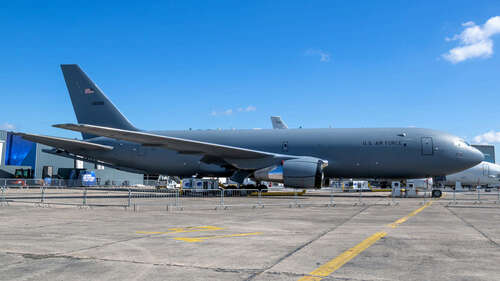
Whereas the Stratofreighter used a “flying boom” refueling system, the Pegasus uses a probe-and-drogue system (aka hose-and-drogue). Instead of a rigid tube, a “long, flexible hose with a funnel-shaped drogue on the end” plugs directly into a retractable probe on the plane needing fuel. This computerized fly-by-wire system can be operated independently from the boom system.
Since the primary function of this plane is to provide fuel to state-of-the-art aircraft, the Pegasus must feature upgrades not seen before. The receiver envelope on the KC-46A’s boom is three times larger than the one found on the old KC-135. It can carry 212,000 pounds of fuel, and since first being delivered to McConnell Air Force Base in Kansas in January 2019, has offloaded more than 100 million pounds of fuel.
The KC-46A isn’t just a passive beast that feeds fuel-starved fighter jets. It’s equipped with combat-ready real-time countermeasures, all of which combine “to detect, avoid, defeat, and survive threats.” Advanced Battle Management System (ABMS) integration can provide the fleet with situational awareness by exchanging data with the planes during refueling. Additionally, it’s hardened against nuclear, chemical, and biological attacks, and the flight deck armor adds another layer of protection.
However, the Pegasus is not without its problems. Not only has it cost Boeing over $7 billion in losses, but it’s also in the midst of fixing several “Category 1 deficiencies” with the aircraft. An Air Force spokesperson said these deficiencies are so severe they “may cause death, severe injury, or severe occupational illness” if not corrected.

